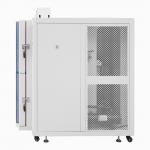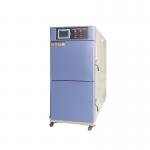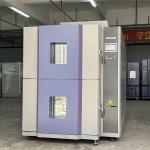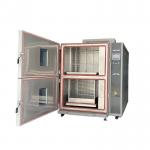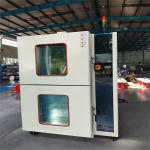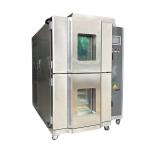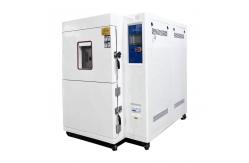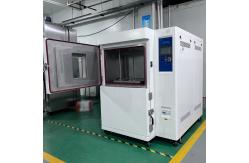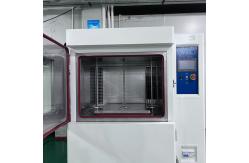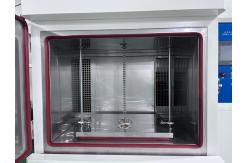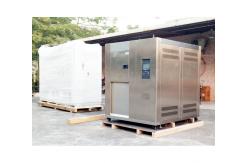In the dynamic and innovation-driven electronics industry, the
reliability and durability of electronic components are
non-negotiable. Customized Thermal Shock Test Chambers for the
Electronics Industry have emerged as a crucial tool for
manufacturers and researchers alike, enabling them to subject
electronic parts to extreme temperature variations and assess their
performance under the harshest thermal stress conditions. These specialized chambers are designed to create rapid and extreme
temperature transitions, precisely simulating the thermal shocks
that electronic components may encounter during their lifecycle.
From the moment a smartphone is taken from a cold winter day into a
warm indoor environment, to the temperature fluctuations
experienced by satellite electronics in the harsh vacuum of space,
these chambers replicate such scenarios. The primary purpose is to
identify any weaknesses or potential failures in electronic
components, circuit boards, connectors, and other parts, ensuring
that they can withstand the rigors of real-world use and maintain
optimal functionality. - Robust and Insulated Chamber Structure
- The chamber is constructed with high-quality, heat-resistant
materials to endure the continuous and intense thermal cycling. The
exterior is typically made of heavy-duty steel, providing excellent
protection against physical damage and maintaining the integrity of
the internal environment. The interior is lined with a smooth,
non-reactive surface to prevent any interaction between the chamber
and the tested components. The insulation used is top-notch,
minimizing heat transfer between the different temperature zones
and ensuring rapid and accurate temperature changes.
- The door of the chamber is engineered for a tight seal. It is
equipped with a reliable locking mechanism and a high-quality
gasket that can withstand the pressure differentials caused by
rapid temperature changes. The door also features a clear viewing
window, allowing users to monitor the testing process without
disturbing the internal temperature conditions.
- Precision Temperature Control Systems
- The temperature control system is highly advanced and accurate. It
can achieve a wide temperature range, usually from -60°C to +180°C.
The system utilizes a combination of powerful heating and
refrigeration elements, along with a sophisticated feedback loop
and multiple temperature sensors strategically placed within the
chamber. This allows for rapid temperature transitions, often
within minutes, which is crucial for replicating real-world thermal
shock conditions.
- The temperature uniformity within the chamber is maintained within
±1°C, ensuring that all parts of the sample are exposed to a
consistent temperature environment during each phase of the test.
The system also has built-in safety features to prevent overheating
or overcooling, protecting both the samples and the chamber itself.
- Efficient Airflow and Transfer Mechanisms
- The chamber is equipped with a high-efficiency airflow system that
ensures rapid and uniform temperature distribution. The airflow is
carefully designed to minimize temperature gradients and ensure
that the samples are exposed to the desired temperature as quickly
as possible. Additionally, the transfer mechanism between the hot
and cold zones is engineered for speed and reliability. It allows
for seamless movement of the samples from one temperature extreme
to the other, without significant temperature fluctuations during
the transfer process.
- The transfer basket or rack used to hold the electronic components
is made of heat-resistant and non-conductive materials, preventing
any unwanted heat transfer or damage to the samples. It is also
designed to be easily removable for convenient loading and
unloading of the test specimens.
- Volume and Dimensions: The chamber can be customized in terms of volume and dimensions
to accommodate different sizes and quantities of electronic
components. Whether it's small microchips or large circuit board
assemblies, the interior space can be optimized to ensure efficient
testing. The external dimensions are also designed to fit into
various laboratory or production facility setups.
- Temperature Range: As mentioned, the chamber can operate from -60°C to +180°C. This
wide range is essential for testing a vast array of electronic
products. For example, components used in automotive electronics
may need to withstand cold starts and engine heat, while those in
aerospace applications must endure the extreme cold of space and
the heat generated during re-entry.
- Temperature Transition Rate: The chambers can achieve rapid temperature transitions, typically
within 5 to 10 minutes. This rate is crucial for accurately
simulating real-world thermal shock conditions. For instance, a
consumer electronic device that is quickly moved from a cold
air-conditioned room to a hot outdoor environment should be able to
handle such rapid temperature changes without malfunctioning.
- Uniformity and Stability: The temperature uniformity within the chamber is maintained
within ±1°C, ensuring that all parts of the tested component
experience a consistent thermal environment. The stability of the
temperature in each zone is excellent, with minimal fluctuations
over time, allowing for accurate and repeatable testing.
- Accurate Simulation of Thermal Shock Conditions
- The main function of these chambers is to precisely replicate the
thermal shock conditions that electronic components face. By
rapidly changing the temperature, it allows manufacturers to
evaluate how well the materials and components can handle the
stress. For example, testing a soldered joint on a circuit board
under thermal shock can reveal if it will crack or separate due to
the expansion and contraction of different materials.
- The ability to program complex temperature profiles and cycling
patterns is also a valuable function. This allows for the
simulation of different real-world scenarios, such as the daily
temperature fluctuations in a desert environment or the temperature
changes during the startup and shutdown of an industrial machine.
By testing under these various conditions, manufacturers can ensure
that their products are robust enough to handle any thermal shock
they may encounter.
- Enhanced Product Quality and Reliability
- Through rigorous thermal shock testing, manufacturers can enhance
the quality and reliability of their electronic products. By
identifying and addressing potential weaknesses early in the design
or production process, they can reduce the risk of field failures.
For example, if a capacitor fails during thermal shock testing, the
manufacturer can modify the design, such as improving the
dielectric material or the encapsulation, to improve its
durability. This leads to increased customer satisfaction and a
lower cost of warranty claims and product recalls.
- The test chambers also help in optimizing product design. By
understanding how different materials and components respond to
thermal shock, engineers can make more informed decisions about
material selection and component placement. This can result in more
efficient and reliable product designs, ultimately giving companies
a competitive edge in the market.
- Compliance with Industry Standards and Regulations
- The electronics industry is highly regulated, and many standards
and regulations require thermal shock testing. These chambers are a
reliable tool for ensuring compliance. For example, components used
in military and aerospace electronics must meet strict thermal
shock resistance requirements. By using these chambers to conduct
tests in accordance with industry standards, manufacturers can
prove that their products meet the necessary criteria, facilitating
market access and building trust with customers and regulatory
bodies.
- Regulatory bodies rely on accurate test results obtained from such
chambers to enforce safety and quality regulations. It serves as a
means for certifying that electronic components can withstand the
thermal stress they may encounter during their normal use, thereby
protecting consumers and maintaining the integrity of the market.
- Stringent Manufacturing Process
- The Customized Thermal Shock Test Chambers for the Electronics
Industry are manufactured under strict quality control procedures.
Each component, from the heating and refrigeration units to the
temperature sensors and insulation materials, is carefully sourced
and inspected for quality and performance. The assembly process is
carried out by highly trained technicians in a clean and controlled
environment, ensuring the proper installation and functionality of
all parts.
- The calibration of the temperature sensors and control systems is a
critical and regular part of the manufacturing process. It is
performed using traceable reference standards to guarantee the
accuracy and reproducibility of the test results. Rigorous quality
audits and inspections are conducted at various stages of
production to maintain the highest level of product quality.
|
